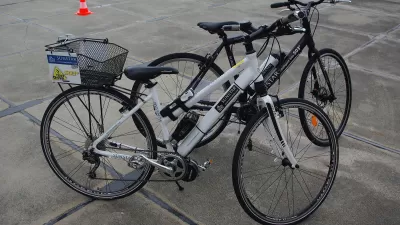Jay Walljasper writing in Yes! Magazine, reports on all the innovations that make Portland the premier cycling city in the U.S.
While investments are being targeted at physical infrastructure, Portland is also engaged in creating a culture of cycling through social marketing campaigns and celebrations.
"[Portland's] plans signal a strategic shift in bicycle planning-a new push to serve more than the 8-10 percent of people who feel at ease biking today. Portland is now focusing on meeting the needs of the 60 percent of people who report in surveys that they're interested in biking more but feel nervous doing it on streets with cars zooming past. Currently, about two-thirds of Portland's 314 miles of bikeways are simple bike lanes, but the city is designing more bike boulevards (residential streets optimized for bike, rather than car, traffic), bike paths (off-street trails through parks or old rail lines), and cycle tracks (bike-only spaces separated from busy streets by a median, grade separation, or wide strip of painted pavement)...The new plan will push bike infrastructure to 5 percent of the city's total transportation budget."
Economic analysis is also revealing that these cycling investments are more than paying for themselves. It is estimated that the region is keeping $800 million in the local economy thanks to cycling, and that bikes are responsible for $1.5 billion in additional economic activity.
FULL STORY: Cycle City, USA

Study: Maui’s Plan to Convert Vacation Rentals to Long-Term Housing Could Cause Nearly $1 Billion Economic Loss
The plan would reduce visitor accommodation by 25,% resulting in 1,900 jobs lost.

Placekeeping: Setting a New Precedent for City Planners
How a preservation-based approach to redevelopment and urban design can prevent displacement and honor legacy communities.

Using Old Oil and Gas Wells for Green Energy Storage
Penn State researchers have found that repurposing abandoned oil and gas wells for geothermal-assisted compressed-air energy storage can boost efficiency, reduce environmental risks, and support clean energy and job transitions.

Washington State Plans Ambitious ‘Cycle Highway’ Network
The state is directing funding to close gaps in its existing bike network and make long-distance trips more accessible.

Homeowners Blame PG&E for Delays in ADU Permits
The utility says it has dramatically reduced its backlog, but applicants say they still face months-long delays for approvals for new electrical work.

Rethinking Wildfire Defense: How a Landscape Approach Can Protect Neighborhoods
Post-fire analysis of the Eaton Fire reveals that a landscape approach — including fire-resistant vegetation, home hardening, and strategic planning — can help reduce wildfire risk, challenging assumptions that trees and plants are primary fire hazards.
Urban Design for Planners 1: Software Tools
This six-course series explores essential urban design concepts using open source software and equips planners with the tools they need to participate fully in the urban design process.
Planning for Universal Design
Learn the tools for implementing Universal Design in planning regulations.
Borough of Carlisle
Caltrans
Heyer Gruel & Associates PA
Institute for Housing and Urban Development Studies (IHS)
City of Grandview
Harvard GSD Executive Education
Salt Lake City
NYU Wagner Graduate School of Public Service
City of Cambridge, Maryland





























